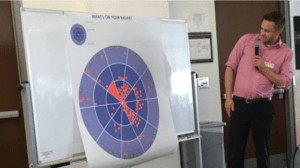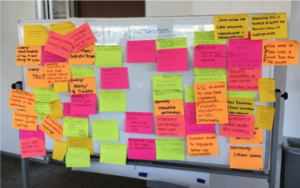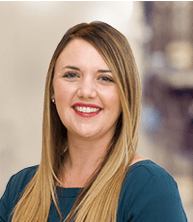By Dianne Olson for EDRBlog.org
Discussing something as significant as the Great Salt Lake involves landscape level topics such as water use among three states that impacts what flows into the lake – or – issues at the microscopic level and the unique ecosystems that thrives or perishes based on the salinity of the water. The Great Salt Lake is as diverse in its impact on the local and state economy of Utah – contributing over 1.3 billion dollars a year to the economy – as it is in the different species of birds visiting the lake in the millions as they migrate, breed, and winter.
On June 21, 2018, University of Utah’s Environmental Dispute Resolution Program and The Langdon Group held the fifth Dialogue on Collaboration bringing together almost 100 people representing 47 different agencies, non-profits and other areas of interest to discuss opportunities where collaboration could play a role in addressing the lake’s most pressing issues.
In preparing for the Dialogue, we conducted many interviews with key stakeholders involved in various aspects of managing, utilizing, and studying the lake. Feedback from the interviews made it clear – issues surrounding the lake are complex. To address the complexity, we needed to find a way to bring our diverse group of participants together in a productive dialogue. Wherein, we could model collaborative approaches without biting off more than we could accomplish in a four-hour window.
Get notified when new articles are posted to the EDR blog – sign up for our email list »
The Challenge – The Great Salt Lake covers a large geographic area with numerous stakeholders involved in complex issues.
The Opportunity – Establish common ground early on to focus participants on an issue of mutual concern.
There were three activities that helped our team facilitate a productive meeting where we could accomplish our objectives:
-
 What’s On Your Radar – As participants arrived, they were given sticker dots that they used to vote on issues that were “on their radar.” These topics came from the issues that we identified through our initial interviews with key stakeholders and ranged from water quality, water quantity, and air quality to wildlife habitat, recreation, and industry. The closer to the center a dot was placed indicated the higher importance of a particular issue.
What’s On Your Radar – As participants arrived, they were given sticker dots that they used to vote on issues that were “on their radar.” These topics came from the issues that we identified through our initial interviews with key stakeholders and ranged from water quality, water quantity, and air quality to wildlife habitat, recreation, and industry. The closer to the center a dot was placed indicated the higher importance of a particular issue.
This simple activity provided, at a glance, where attendee’s interests were, allowing facilitators to check their assumptions about what we thought was important. This set the stage for small group discussions which further explored challenges and opportunities for collaboration on priority issues.
- Small Group Discussions – This format provided an opportunity for individuals to explore their own unique experience and beliefs around the Great Salt Lake and process the different perspectives from other participants and information provided on the topic. Exploring new perspectives and new information through a respectful dialogue generated the most dialogue and energy during the day. Our team heard many examples of attendees creating new beliefs based off this exercise. Consequently, many saw where their organization could take ideas generated through the small groups to create and/or provide different experiences for people through education, engagement, outreach, programming, or establishing collaborative efforts.
-
 Reporting Back – Reporting back is often under-utilized, but the benefit provides another opportunity to elevate issues of mutual concern. As small groups discussed reactions to challenges surrounding the lake, they were encouraged to identify three collaboration opportunities and their associated challenges. Ideas from each group were grouped together with other groups by topic or theme. Physically placing the collective brainstorming ideas in front of the group, summarized and broke down complex issues into more manageable pieces and the group could see emerging themes at a glance.
Reporting Back – Reporting back is often under-utilized, but the benefit provides another opportunity to elevate issues of mutual concern. As small groups discussed reactions to challenges surrounding the lake, they were encouraged to identify three collaboration opportunities and their associated challenges. Ideas from each group were grouped together with other groups by topic or theme. Physically placing the collective brainstorming ideas in front of the group, summarized and broke down complex issues into more manageable pieces and the group could see emerging themes at a glance.
At the end of the event, we had identified a few key issues of mutual concern and established initial ideas where collaboration could be initiated or strengthened moving into actionable steps. Not only did the Dialogue facilitate a shift in individual beliefs and perspectives, through simple innovative activities the collective group broke down the complexity surrounding the lake into common interests and a collaborative framework where stakeholders can engage and move into action.
 Dianne Olson is a Project Manager for The Langdon Group. She has worked for over 15 years with federal and state land management agencies on recreation management and outreach. Her work includes creating proactive, collaborative, and innovative approaches to public engagement that moves planning into action on the ground with focus on issues and values unique to each community.
Dianne Olson is a Project Manager for The Langdon Group. She has worked for over 15 years with federal and state land management agencies on recreation management and outreach. Her work includes creating proactive, collaborative, and innovative approaches to public engagement that moves planning into action on the ground with focus on issues and values unique to each community.
